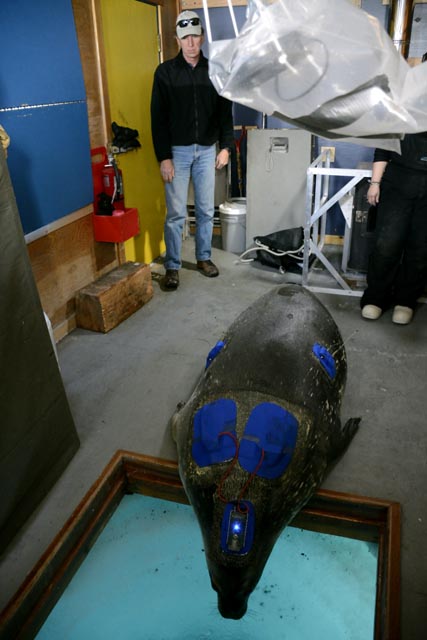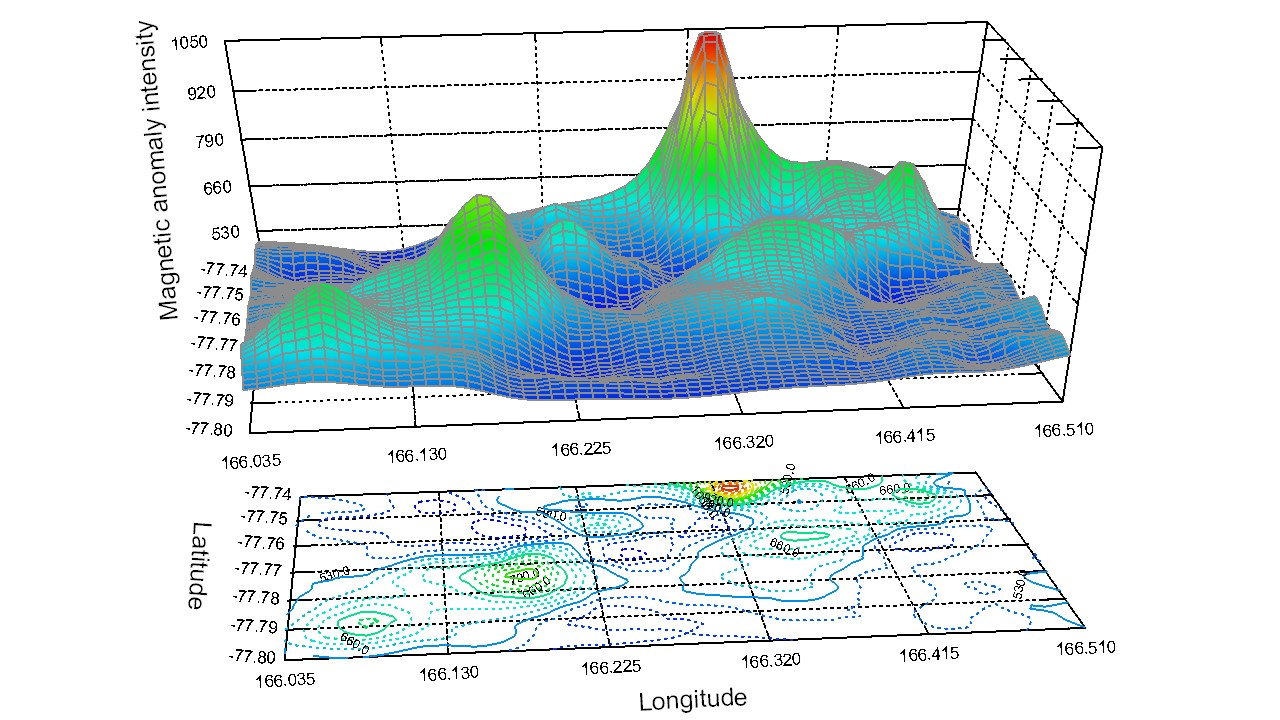|
Read a transcript of this video |
Video Information |
Story by Peter Rejcek, Produced by Ralph Maestas
Magnetic personality?Scientists investigate how Weddell seals navigate under sea icePosted December 22, 2014
Weddell seals spend much of their lives swimming and hunting for prey underneath Antarctic sea ice. These marine mammals – capable of diving down hundreds of meters in the frigid waters of the Southern Ocean for nearly an hour at a time – must still return to the surface to take a breath now and then. Key to that strategy are holes and cracks in the sea ice where seals can grab a few gulps of fresh air before the next plunge. The animals have shown an uncanny ability to relocate such refuges from a distance of a kilometer or more, making a beeline back as if following some sort of biological GPS. 
Photo Credit: Peter Rejcek
Scientists Lee Fuiman watches as a newly instrumented Weddell seal with a Video and Data recorder enters a dive hole.
That capability caught the attention of a team of researchers who have been working together for more than 15 years on a series of studies focused on how Weddell seals hunt under ice. Now the group, with funding from the National Science Foundation, is focusing on how the seals navigate under ice. “This animal, we think, may be highly evolved with an ability to navigate using magnetic sense in order to find ice holes some distance apart and get back to them safely,” explained Randall Davis, a professor in the Department of Marine Biology at Texas A&M University. If the hypothesis turns out to be true – that Weddell seals possess a sixth sense that allows them to follow the Earth’s magnetic field while swimming through an ice-covered environment – it would represent the first evidence of such a trait in a marine mammal. The idea that Weddell seals can unerringly follow magnetic lines dates back to the late 1990s when the team first started working together in Antarctica. Lee Fuiman, associate director of the University of Texas’ Marine Science Institute in Port Aransas, said he was struck by data from the very beginning that showed the seals returning to dive holes with amazing precision. “The animal always found its way back. It’s like he knew exactly where the hole was,” Fuiman marveled. “I couldn’t figure out how they would do that. How did they know where they were by the time they turned around?” The question is more than academic. It’s about life and death for Weddell seals, which like all mammals, require oxygen to breathe, despite their mostly aquatic environment. Time spent looking for a new place to surface after each dive would not only be inefficient given the energy required to swim and hunt, but failure to locate a hole in the ice means the animal would drown. NSF-funded research
NSF-funded research in this article: Randall Davis, Texas A&M University, Award No. 1341469
Lee Fuiman, University of Texas at Austin, Award No. 1341441 Terrie Williams, University of California, Santa Cruz, Award No. 1341401 National Marine Fisheries Service permit #18691-00. “These animals are doing a remarkable amount of exercise all while on breath hold,” notes Terrie Williams, a professor of ecology and evolutionary biology at the University of California, Santa Cruz. She is an expert on physiology in the Weddell seal, an animal whose apparent lethargy on the surface of the sea ice belies an amazingly athleticism below it. “The reason a seal wants to be efficient is that they have a limited amount of oxygen onboard,” she explained further. “The trick is conserving that ‘scuba tank’ on a dive.” It makes sense that an aquatic mammal whose survival depends on reliably finding its way back to surface would evolve with at least one strategy for that purpose. To test whether that behavior involves tracking magnetic lines, the team recruited an expert in the field of magnetoreception – Michael Walker at the University of Auckland, who works on magnetic senses in birds and other animals – and began a series of experiments in McMurdo Sound this year. Getting to the core of navigationThe Earth’s magnetic field is largely a result of its iron core, about two-thirds as wide as the moon. It’s been called a world within a world, as it spins at its own rate and has its own liquid ‘ocean’ known as the outer core. The Earth’s rotation produces a type of whirlpool in the outer core that generates the planet’s magnetism. However, there is local variation to the worldwide magnetic field, what Walker calls “nonsystematic magnetism.” That’s particularly true in areas where molten iron in the form of magma has reached the surface and cooled, becoming magnetized, from processes resulting from geologic forces like volcanism or seafloor spreading. 
Graphic Credit: Lee Fuiman
A three-dimensional model, above, and two-dimensional look at some of the magnetic field strengths in McMurdo Sound.
In particular, Walker’s research on homing pigeons around field sites outside of Auckland, where there is the remnant of ancient volcano, has shown that the flight pattern of the birds suggest they use both the local and global magnetic fields to navigate. “We suspect that is enabling them to sample both residual field and the field produced in the core of the Earth. Somehow they’re using some tricks in the brain that allows them to figure out where they are relative to home,” he explained. Ross Island, home to McMurdo Station, is another place with complex magnetic fields, thanks to its volcanic past. The world’s southernmost active volcano, Mount Erebus, looms over the volcanic island. The team spent a couple of weeks in October towing a magnetometer around the sea-ice surface of McMurdo Sound, carefully mapping the nonsystematic magnetism, creating both two-and three-dimensional maps. The former look like topographical maps, with the contours representing varying degrees of magnetism rather than elevation. If the Weddell seals have a nose for magnetism, their dive behavior should be reflected in the maps of magnetic anomalies. “We think there’s a method to this madness,” Walker said. |



For USAP Participants |
For The Public |
For Researchers and EducatorsContact UsU.S. National Science FoundationOffice of Polar Programs Geosciences Directorate 2415 Eisenhower Avenue, Suite W7100 Alexandria, VA 22314 Sign up for the NSF Office of Polar Programs newsletter and events. Feedback Form |

